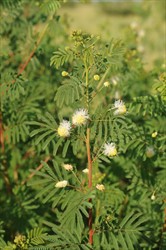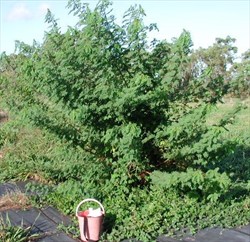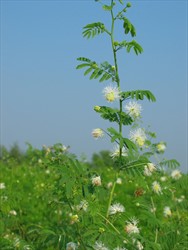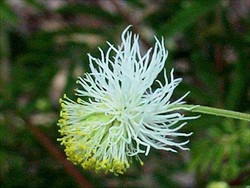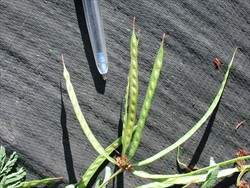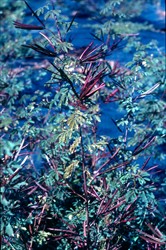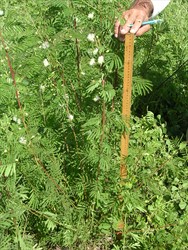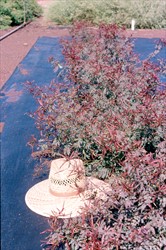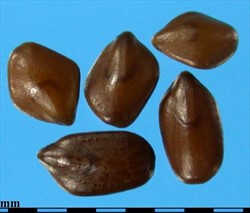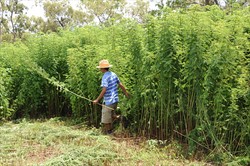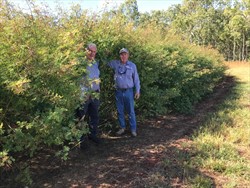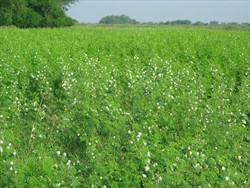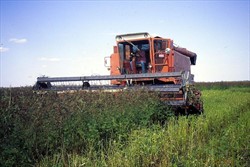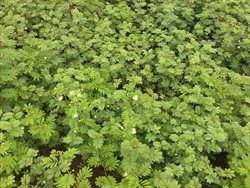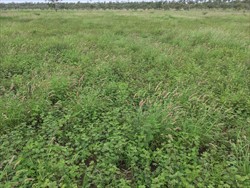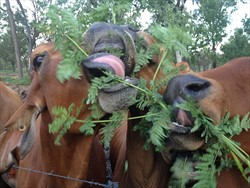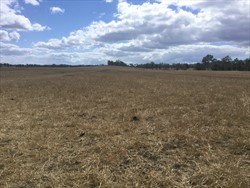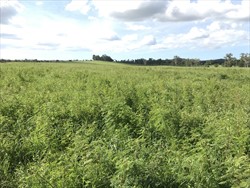Desmanthus bicornutus
Tropical Forages
Desmanthus bicornutus S. Watson
Acuan subulatum Britton & Rose; Desmanthus subulatus (Britton & Rose) Wiggins ex B.L. Turner
Family: Fabaceae (alt. Leguminosae) subfamily: Caesalpinioideae (mimosoid clade*) tribe: Mimoseae.
* Azani, N. et al. [97 authors from 54 institutions] 2017. A new subfamily classification of the Leguminosae based on a taxonomically comprehensive phylogeny. Taxon 66: 44–77.
Subshrub or shrub, to 1.5‒3 m tall, unbranched or multiple ascending branches from the base; taproot woody, cylindrical, branched, to 70 cm long. Young stems hairless, often deep red in colour, 4-angled, stem-base with smooth, light brown bark; older stems hairless, shiny red or brown. Leaves 9‒18 cm long, petiole 0.3‒1.1 cm, rachis 3.4‒10 cm long, sparsely puberulent with straight, slender trichomes, nyctinastic; paribipinnate with 6‒14 pairs of pinnae 1.5‒4.6 cm long, the lowest pair bearing an ovate to elliptic, sessile, crateriform nectary, 0.6‒1.5 mm in diameter; 18‒45 pairs of pinnules 2.7‒5.4 (‒6.3) mm long and 0.7‒1.3 mm wide, linear, slightly falcate. Stipules (1.2‒) 3‒6 ‒7.8) mm long, sometimes deciduous with age. Capitulum (flower head) 0.8‒1.7 cm long, occurring singly or in pairs in leaf axils on peduncles 1.5‒3.7 cm long; containing 25‒60 (‒67) flowers that may be perfect, functionally male or sterile; sterile flowers (8‒20), white or pale green, occur at the base of the head; 0‒6 male flowers towards the base of the head, above the sterile flowers, and below the perfect flowers; perfect flowers (16‒40) occur apically, 6‒20 being functionally perfect, the remainder being functionally male because the style fails to elongate. Pods borne in groups of 2‒12 (‒19) on fruiting peduncles 1.5‒5.0 cm long; pods 4.6‒10 cm long and (1.8‒) 2.7‒4.5 (‒5.5) mm wide, linear, straight or curved, bearing an acuminate to attenuate beak 2‒14 mm long; valves chartaceous, glabrous, red when immature, dark-brown at maturity, opening along both sutures (some retaining seed for some time after maturity); (7‒) 10‒17 (‒22) seeds per pod. Seeds 2.5‒3.7 × 2.0‒2.8 (‒3.6) mm, ovate to rhomboidal, brown. 122,000‒230,000/kg.
English: bundleflower (also generic), rayado bundleflower, ruby bundleflower, two-horn bundleflower (USA)
Latin America: malvilla de laguna (Sinaloa, Mexico); guaje de ratón (Guerrero, Mexico); dais, siteporo, jíchiquia (Spanish)
Native:
Northern America: Mexico (Baja Sur, Chihuahua, Colima, Guerrero, Jalisco, Mexico, Michoacán, Nayarit, Sinaloa, Sonora); USA (Arizona)
Naturalized:
Northern America: Mexico (Veracruz)
Forage
D. bicornutus is a component of grazed grasslands in its native habitat in northern Mexico and southern Arizona, USA. Used as a legume component of sub-humid grasslands under grazing.
Environment
This is a new species to cultivation, and environmental applications are yet to be defined, although there are indications that Desmanthus spp. may have anti-methanogenic potential and could play an important role in reducing greenhouse gas emissions from ruminant livestock.
Other
Seeds are eaten in a salsa in Guerrero, Mexico.
Occurs from 0 to 1,400 m asl along washes, roadsides, canyons and watercourses at lower elevations and in oak woodland or grassland areas at higher elevations.
Soil requirements
D. bicornutus occurs on sandy, rocky and clay soils in its native range. Specimens in the Australian collection mostly came from clay or loam soils (one from gravel), with pH between 7 and 8 (one a loam of pH 6). Experience in S Texas, USA and in N Queensland, Australia suggests the best success is obtained when sowing into neutral or alkaline clay soils, although some success has been obtained on soils with the pH as low as 6. The plant has also performed quite well on sandy loam and sandy clay loam soils if pH is suitable, but not on sands.
Moisture
Occurs over a wide annual rainfall range from 300 mm in Arizona, USA to 1,300 mm, occasionally to 2,000 mm in coastal, southeast Mexico. These environments have intense dry seasons of 3‒10 months in duration. Average annual rainfall at collection sites for the Australian collection were (200‒) 300‒ 800 (‒2,000) mm. Cultivars have been released primarily for use in sub-humid to semi-arid environments
Temperature
Average annual temperatures in the native range are also highly variable from 20 °C in Arizona, USA, with a range of 11‒32 °C for the coldest and hottest months, respectively, to 25.5 °C in southeast Mexico, with a range of 20‒30 °C for the coldest and hottest months, respectively.
Light
May possess some shade tolerance, being an understorey component of a range of scrub, forest and woodland types.
Reproductive development
Flowering occurs August to November and fruiting occurs predominantly September to December in the native range (Mexico and southern USA, 18‒32° N), equivalent to February to May and March to June in the southern hemisphere. There is a light flowering in spring in Mexican accessions sown in the northern subtropics, with a more intensive flowering in autumn. It has been observed that flowering and seed set can be greatly modified by drought and heat stress, and if soil fertility or moisture variation exists within a field, flowering within a field may range across 2 weeks.
Defoliation
Tolerant of regular heavy grazing pressure. However, in a grazing trial (rotational cycle of 7-day grazing and 21-day rest) where sheep selectively grazed the legume over the companion Cynodon dactylon, 20% of the D. bicornutus plants died by the end of the 178-day trial. By comparison, all plants died in the D. pubescens treatment.
Fire
Will regrow after fire.
Guidelines for establishment and management of sown forages.
Establishment
Freshly harvested seed can have a hard seed content of >90%. This should be reduced to less than 50% by hot water or abrasion prior to sowing. Sow 1–2 kg/ha of scarified seed at a depth of 0.5–2.0 cm into moist soil with at least 50–60 cm depth of soil moisture to ensure establishment. Deeper sowing depths may prevent or delay emergence. Surface broadcasting onto a well-prepared seedbed, followed by rolling, or planting using a “crocodile” seeder have also given good results. Has been established successfully into cultivated strips, or sod-seeded into slashed back pasture treated with glyphosate to suppress grass growth. Dissemination through feeding unscarified seed to cattle has also been shown to be effectve, seed being scarified during passage through the animal and germinating in the dung. Care should be taken using this approach with small ruminants since work has shown that much higher percentages of seed may be digested by sheep. With conventional sowing methods, higher sowing rates of 3‒4 kg/ha of seed provide some insurance against "false starts" as often occurs in some of the areas where D. bicornutus will be sown. Remaining viable seed is then able to establish in following seasons. While Desmanthus spp. are not highly specific in their rhizobial demands and may nodulate effectively on native rhizobia, it may be advantageous to inoculate seed with a known effective strain of rhizobium such as CB 3126 recommended in Australia. The presence of native Neptunia spp., a genus closely related to Desmanthus, may indicate presence of an effective rhizobial strain.
Fertilizer
Fertilizer is rarely needed on the clay soils in the areas where D. bicornutus will be sown. However, if the area has been regularly cropped, or if there is any indication of nutrient deficiency, application of appropriate fertilizer may be necessary.
Compatibility (with other species)
Some accessions are compatible with buffel and native grasses of western Queensland and other accessions compatible with tall native grasses on the wet/dry tropical coast of northern Queensland.
Companion species
Grasses: Astrebla spp., Cenchrus ciliaris, Dichanthium sericeum, Heteropogon contortus, Panicum virgatum, Themeda triandra, or other tussock grasses adapted in the area.
Pests and diseases
A native Acizzia sp. (Hemiptera: Psyllidae) has had some effect on various Desmanthus spp. in southern Queensland, but few other problems have been reported.
Ability to spread
Has not spread from 14 year old trial plots in western Queensland.
Weed potential
D. bicornutus is a prolific seeder if left ungrazed, and seed can be disseminated by animals when grazing resumes. It is an abundant roadside weed across its native range, and must be considered to have the potential to colonise disturbed areas when conditions favour following introduction to new environments.
Nutritive value
Crude protein levels of tops range from 15 to 27%. 20% in the early summer to about 17% in the late summer/early fall
Palatability/acceptability
Tests under grazing have shown that D. bicornutus is palatable to cattle, goats and sheep, as well as browsing wildlife. In semi-arid western Queensland it is grazed to ground level.
Toxicity
No evidence of anti-nutritional or toxic effects of feeding D. bicornutus to livestock.
Dry matter
Annual DM yields mostly range from 4.5 to 7.8 t/ha, but a line registered as JCU 6 (see cultivars) has yielded 24 t/ha DM.
Animal production
Inclusion of Desmanthus spp. in mixed grass legume pastures has been shown to improve liveweight gain in cattle. Steers on a mixed buffel grass (Cenchrus ciliaris) - Desmanthus pasture gained 40 kg/head over the 90 day cool/dry season, while those on buffel grass alone had a nett gain of 10 kg/head.
Most plant improvement in this species was initially effected through a process of selection among accessions within wild-type collections. The next stage in this process has been to revisit old evaluation sites to collect surviving phenotypes with followup testing for genetic shift from original populations. More recent work is evaluating possibilities of intra- and inter-specific crossing using emasculation of flowers of the intended female parent. The basic chromosome number for Desmanthus is x = 14; no record found for the chromosome number for D. bicornutus.
While well-managed late-season seed crops can yield 450 kg/ha, early season yields are generally much lower and may not be economical to harvest.
D. bicornutus was not killed by any of a range of selective grass herbicides used in Texas. Imazethapyr can be safely used >2 weeks before sowing to about 10‒15 cm stage. It is killed by the woody weed herbicide, Access®,(120 g/L picloram and 240 g/L triclopyr).
- Well-adapted to seasonally dry sub-humid and semi-arid environments.
- Tolerant of alkaline, sodic, saline and heavy clay soils.
- Drought tolerant.
- Grazing tolerant.
- High feeding value.
- High seed yields.
- Recruitment in the years following planting is limited by hardseededness.
- Moderately specific rhizobium requirements.
Burt, R.L. (2016) Searching for pasture legumes for heavy clay soils in Australian dry tropics and subtropics: IV. Evaluation in Western Queensland. In: Lazier, J.R. and Ahmad, N. (eds) Tropical forage legumes: Harnessing the potential of Desmanthus and other genera for heavy clay soils. CAB International, Wallingford, Oxon, UK. p. 204–253. doi.org/10.1079/9781780646282.0204
Cox, K.G. and Harrington, K.C. (2005) Selective herbicide strategies for use in Australian Desmanthus seed crops. Tropical Grasslands 39:171–181. bit.ly/2WNQC7G
Gardiner C.P. and Burt R.L. (1995) Performance characteristics of Desmanthus virgatus in [1] [2] [3] two contrasting tropical environments. Tropical Grasslands 29:183–187. bit.ly/2QRiB2J
Gardiner, C.P. (2016) Developing and commercializing new pasture legumes for clay soils in the semi-arid rangelands of northern Australia. In: Lazier, J.R. and Ahmad, N. (eds) Tropical forage legumes: Harnessing the potential of Desmanthus and other genera for heavy clay soils. CAB International, Wallingford, Oxon, UK. p. 283–304. doi.org/10.1079/9781780646282.0283
Gardiner, C.P., Ossiya, S.A. and Rangel, J.H.A. (2017) Discontinued legume trials yield potentially valuable genotypes. Proceedings of the 18th Australian Society of Agronomy Conference. Ballarat, Australia, 24–28 September 2017. bit.ly/2JkWv4n
Hopkinson, J.M. and English, B.H. (2004) Germination and hardseededness in Desmanthus. Tropical Grasslands 38:1–16. bit.ly/2wyIPA7
Luckow, M. (1993) Monograph of Desmanthus (Leguminosae-Mimosoideae). Systematic Botany Monographs Vol. 38. American Society of Plant Taxonomists, Laramie, WY, USA. doi.org/10.2307/25027822
Ocumpaugh, W.R., Grichar W.J., Hussey Jr M.A., Abrameit A.H., Owens, M.K., Reed R.L, Muir J.P., Bade D. and Reilley J.L. (2004) Registration of ‘BeeTAM‐06’ Bundleflower. Crop Science 44:1860–1861. doi.org/10.2135/cropsci2004.1860
Pengelly, B.C. and Liu, C.J. (2001) Genetic relationships and variation in the tropical mimosoid legume Desmanthus assessed by random amplified polymorphic DNA. Genetic Resources and Crop Evolution 48:93–101. doi.org/10.1023/A:1011234913710
'BeeTAM 06' (CPI 90906, PI 634750, CIAT 22510) Released as a component of the 4-way commercial 'BeeWild' blend in Texas, USA (2004) Origin Sinaloa, Mexico (24°35' N, 2 m asl, rainfall 650 mm). Selected to improve the feed resource for wildlife and livestock.
'BeeTAM 08' (CPI 84508, PI 634751, CIAT 22784, ILRI 14396) Released as a component of the 4-way commercial 'BeeWild' blend in Texas, USA (2004) Origin Sinaloa, Mexico (23°10' N, 10 m asl, rainfall 750 mm). Selected to improve the feed resource for wildlife and livestock.
'BeeTAM 37' (CPI 81337, PI 634752, CIAT 32322) Released as a component of the 4-way commercial 'BeeWild' blend in Texas, USA (2004) Origin Sinaloa, Mexico (25°03' N, 200 m asl, rainfall 450 mm). Selected to improve the feed resource for wildlife and livestock.
'BeeTAM 57' (CPI 90857, PI 634753, CIAT 22507, ILRI 14386) Released as a component of the 4-way commercial 'BeeWild' blend in Texas, USA (2004) Origin Sonora, Mexico (27°40' N, 300 m asl, rainfall 350 mm). Selected to improve the feed resource for wildlife and livestock.
'JCU 4' Granted PBR protection in Queensland, Australia (2015) Derived from a selected plant (putative parent CPI 90857) growing in a mixed sward of Desmanthus spp. from an old trial planting at Isisford, Qld (24.26° S, 200 m asl, rainfall 450 mm). Progeny of the originally selected plant have undergone a further 5 generations of selection for visual genetic uniformity prior to release. Component of the multi-species commercial ProgardesTM blend. Used for pasture improvement on dark clay soils in semi-arid zone.
'JCU 6' Granted PBR protection in Queensland accepted (2018) Derived from plants (putative parent CPI 91162) selected from old plots at James Cook University, Townsville. In subsequent trials at 6 sites over a range of sub-humid sites on a range of soil types including slightly acid duplex soils with a silty sandy loam top soil, ‘JCU6’ ranked highly compared with other Desmanthus genotypes, particularly for leafiness and bulk.
CPI 90857 (PI 634753, CIAT 22507, ILRI 14386) Selected in Australia. Productive and persistent on pebbly clay soils in semi-arid 450 mm rainfall area of northwestern Queensland. Extremely drought tolerant. (See also cultivars 'BeeTAM 57', 'JCU 4'.)
CPI 91162 (CIAT 22570) Selected in Australia. Origin Guerrero, Mexico (18°24' N, 340 m asl, rainfall 800 mm) Productive shrub in wet/dry tropics of northeastern Queensland, AAR 1,200 mm. Has persisted in trial plots in shaded Eucalypt woodland savannah for 10 years. Regrew after fire. Good seed production. (See also cultivar 'JCU 6').
